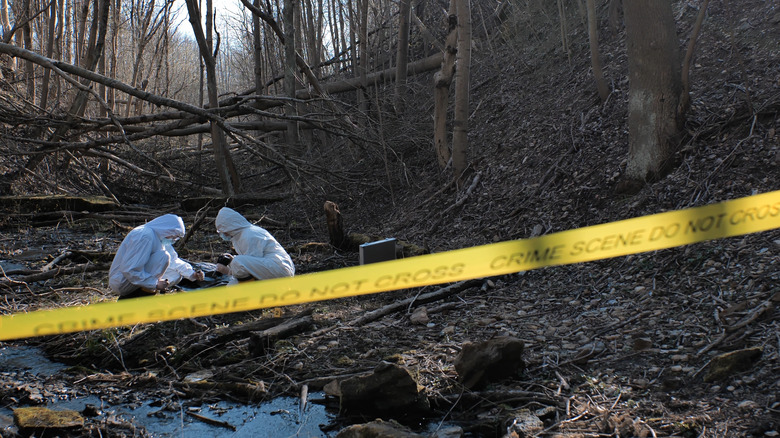How An Article Of Clothing Finally Led To Justice In Janie Landers' Murder
In 1979, an Oregon woman named Janie Landers walked away from her vocational training program and was never seen alive again. Days later, police found the body of the 18-year-old woman who, though being an adult, mentally functioned at the age of an 8-year-old due to her developmental disabilities. As A&E TV reports, authorities identified and then later ruled out several suspects, and the case went cold. Decades passed, and Landers' sister began pressuring the local authorities to look into her case again, now that testing DNA evidence had become a widespread and reliable way to prosecute crimes.
When a fresh pair of eyes was brought in to look things over, the detective assigned to the case noticed something that previous investigators had overlooked: the victim's wounds suggested that the assailant might have been injured in the attack. Sure enough, the assailant's blood was on Landers' shirt, and police had a sample of his DNA. A few computer analyses later, they'd found their man. Landers finally got justice nearly 40 years after her death.
Life In A Group Home
Janie Landers went missing on March 9, 1979, according to the Statesman Journal. That day, she'd attended classes at Fairview Training Center, a state-run training and residential facility for individuals with developmental disabilities that has since been closed down. When she walked away from her classroom, staff assumed she was going back to the group home where she lived, which was on campus and a short distance away (per A&E TV).
Landers was known to have behavioral issues in the home, which was itself bedeviled by the abusive and cruel treatment of residents. Further still, Landers did not get along with her roommate, Cheryl, or her roommate's boyfriend, Ray. In one incident, Landers poured hot chili on Cheryl, giving her severe burns. Ray made statements indicating he wanted to harm Landers.
Landers, for her part, had run away from the group home before but had always returned. But when the hours stretched on March 9, and she failed to return, police soon had a missing person case.
Suspects Identified and Cleared
A few days after she went missing from her group home, Janie Landers' body was found on March 14, 1979, according to KOBI. She'd been beaten and stabbed, and her cause of death was later determined to be blunt force trauma to the head. She had not been sexually assaulted.
Police had no shortage of subjects and persons of interest. First, they wanted to talk to the last person to see her alive: Bill Graf, an instructor at the training center. Not only was he the last to see her alive, but a witness later alleged that a person matching his description was seen talking to Landers off-campus (via A&E TV). However, he easily passed a polygraph test. Cheryl and Ray were also eliminated as suspects.
From there, the case went cold, and it would go unsolved for the next four decades; that is, until a new set of eyes was put on the case, and the new investigator noticed something that had eluded previous detectives. Ultimately, DNA evidence helped them finally close this chapter in Oregon's criminal history.
A Break In The Case
Janie Landers' case went cold in the early 1980s after multiple suspects had been identified and cleared. However, in 2015, Landers' sister, Joyce Caldwell, began pressuring authorities to look at the case again (via A&E TV). Caldwell was convinced that DNA evidence, now a routine part of criminal investigations, could help solve her sister's murder. However, police weren't hopeful, as she hadn't been sexually assaulted and, thus, no semen from her assailant to be entered into evidence.
Nevertheless, Oregon State Police Detective Steve Hinkle decided to take a look, and he noticed something that others had missed: Landers' stab wounds suggested that she was stabbed with a knife without a hilt. Using such a weapon in a violent assault, particularly against a victim who is fighting back (Landers was known to be feisty and have surprising strength), could lead to the assailant getting cut as well. Sure enough, the assailant did leave some blood at the crime scene, including on Landers' shirt. The garment was sent to a lab for testing, the DNA extracted being matched against a database, and just like that, authorities had their man.
Gerald Dunlap
Three and a half decades after her murder, DNA evidence finally identified the man responsible for killing Janie Landers: a convicted sex offender named Gerald Dunlap.
As KOBI reports, Dunlap had died in prison in 2002, 13 years before he was identified via DNA evidence as Landers' killer. He had a lengthy rap sheet of sexual crimes going back to 1961 when he'd been sentenced to life in prison for a sexual assault but only did 12 years. Authorities pieced together his movements and found that he had worked at Fairview. Sex offender registries weren't a thing when he was hired there, so no one would have known about his criminal past unless he'd volunteered the information, which he did not.
Authorities believe that Dunlap had planned to sexually assault Landers but, thwarted by her unexpected strength and willingness to fight back, was unable to, so he murdered her instead. "If Dunlap was alive, the District Attorney's Office would have filed a Murder charge in this matter. His death in 2002 means that no further action can be taken in this case," the district attorney wrote (per KOBI).
Although Landers never got justice, her sister Joyce Caldwell said she is still glad to have closed this chapter in her life. "I'm really grateful and relieved that it's done," she said (via the Statesman Journal).




